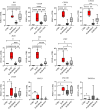Side-to-side characterisation of cellular content, soluble factors and in vitro potential on chondrocytes for bone marrow aspirate concentrate and adipose-derived stromal vascular fraction
- PMID: 40357029
- PMCID: PMC12066993
- DOI: 10.1002/jeo2.70254
Side-to-side characterisation of cellular content, soluble factors and in vitro potential on chondrocytes for bone marrow aspirate concentrate and adipose-derived stromal vascular fraction
Abstract
Purpose: Orthobiologics gained popularity for the treatment of musculoskeletal pathologies, including osteoarthritis (OA). Bone marrow aspirate concentrate (BMAC) and adipose-derived stromal vascular fraction (SVF) were reported to reduce OA symptoms, contributing to the restoration of joint homoeostasis. Variability in production protocols and lack of extensive characterisation hinder a clear indication for the choice of a product over the other. The purpose of this study was to characterise side-by-side BMAC and SVF obtained with the same family of devices, by assessing cell immunophenotype, release of soluble factors and their ability to reduce inflammation in a pathologic in vitro chondrocyte model.
Methods: BMAC (iliac crest) and SVF (abdomen liposuction) were obtained from 28 (55 years old ± 8) and 39 patients (56 years old ± 9), with Hy-Tissue BMAC and Hy-Tissue SVF. BMAC/SVF were characterised for cellular content. The number of mesenchymal stromal cells (MSCs) was investigated by flow cytometry (CD45-CD31-CD34+CD90+CD105-/LCD146-, adipose-MSCs; CD45-CD271+, bone marrow-MSCs). Two-hundred factors (cytokines, chemokines, receptors, growth factors and inflammatory molecules) were tested by enzyme-linked immunosorbent assay (ELISA). Anti-inflammatory potential was assayed in vitro on interleukin-1 beta (IL1β)-treated chondrocytes by quantitative reverse transcription polymerase chain reaction (qRT-PCR) arrays of 84 genes involved in inflammatory processes.
Results: BMAC had higher concentration for white cells (213x), erythrocytes (49x) and platelets (25x), while the number of MSCs resulted comparable between the two products (1000 cells/mL). One-hundred and twenty-one soluble factors were identified in all analysed samples, with 88 more abundant in BMAC and one in SVF. Gene ontology revealed that the higher concentrated molecules were mainly growth factors and/or involved in differentiation processes. Both orthobiologics reduced inflammation in the in vitro chondrocyte model, with BMAC showing higher efficacy.
Conclusions: Using specific commercial systems, both orthobiologics showed anti-inflammatory effects in vitro. BMAC had higher blood cell and growth factor concentrations than SVF, with greater efficacy. However, variability in commercial systems limits generalisation, requiring further study to draw conclusions when different devices are employed.
Level of evidence: NA.
Keywords: cartilage; mesenchymal stromal cells; orthobiologics; osteoarthritis; soluble factors.
© 2025 The Author(s). Journal of Experimental Orthopaedics published by John Wiley & Sons Ltd on behalf of European Society of Sports Traumatology, Knee Surgery and Arthroscopy.
Conflict of interest statement
The authors declare no conflicts of interest.
Figures







Similar articles
-
Clinical Efficacy of Bone Marrow Aspirate Concentrate Versus Stromal Vascular Fraction Injection in Patients With Knee Osteoarthritis: A Systematic Review and Meta-analysis.Am J Sports Med. 2022 Apr;50(5):1451-1461. doi: 10.1177/03635465211014500. Epub 2021 Jun 8. Am J Sports Med. 2022. PMID: 34102078
-
Quantitation of progenitor cell populations and growth factors after bone marrow aspirate concentration.J Transl Med. 2019 Apr 8;17(1):115. doi: 10.1186/s12967-019-1866-7. J Transl Med. 2019. PMID: 30961655 Free PMC article.
-
Harvest and Application of Bone Marrow Aspirate Concentrate to Address Acetabular Chondral Damage During Hip Arthroscopy.JBJS Essent Surg Tech. 2023 May 24;13(2):e22.00010. doi: 10.2106/JBJS.ST.22.00010. eCollection 2023 Apr-Jun. JBJS Essent Surg Tech. 2023. PMID: 38274149 Free PMC article.
-
Medicinal signaling cells niche in stromal vascular fraction from lipoaspirate and microfragmented counterpart.Croat Med J. 2022 Jun 22;63(3):265-272. doi: 10.3325/cmj.2022.63.265. Croat Med J. 2022. PMID: 35722695 Free PMC article.
-
Safety and Efficacy of Bone-Marrow Aspirate Concentrate in Hip Osteoarthritis: A Systematic Review of Current Clinical Evidence.Indian J Orthop. 2024 May 17;58(7):835-844. doi: 10.1007/s43465-024-01183-7. eCollection 2024 Jul. Indian J Orthop. 2024. PMID: 38948376 Free PMC article. Review.
References
-
- Andersen CL, Jensen JL, Ørntoft TF. Normalization of real‐time quantitative reverse transcription‐PCR data: a model‐based variance estimation approach to identify genes suited for normalization, applied to bladder and colon cancer data sets. Cancer Res. 2004;64:5245–5250. - PubMed
-
- Bendinelli P, Matteucci E, Dogliotti G, Corsi MM, Banfi G, Maroni P, et al. Molecular basis of anti‐inflammatory action of platelet‐rich plasma on human chondrocytes: mechanisms of NF‐κB inhibition via HGF. J Cell Physiol. 2010;225:757–766. - PubMed
LinkOut - more resources
Full Text Sources
Research Materials
Miscellaneous

